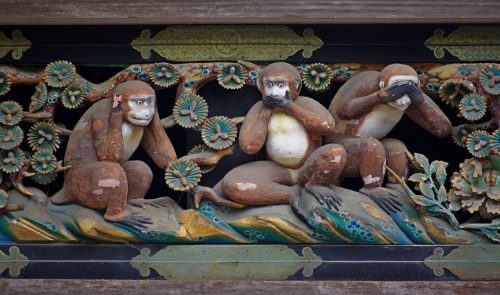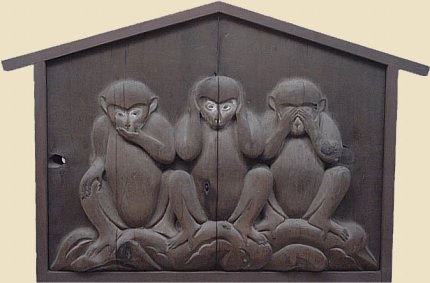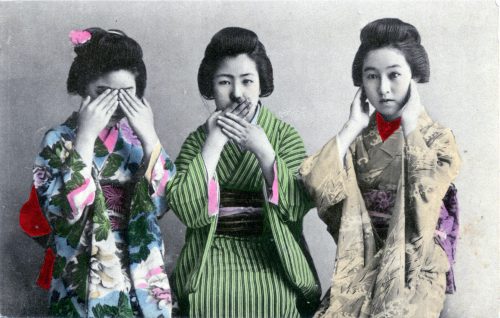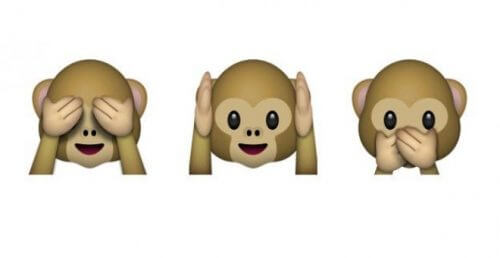The Fascinating Lesson of the "Three Wise Monkeys"


Written and verified by psychologist Valeria Sabater
The classic story of the three wise monkeys from the Tōshō-gū shrine has a simple, timeless lesson: we have be careful what we say, hear, and see.
This famous shrine is in Japan. The carvings of the monkeys – one covering his mouth, another his eyes, and the last one his ears – date back to 1636.
Few images have crossed as many borders and lasted for as many decades as these. Now, the three wise monkeys are are icon. However, the meaning of this image slowly became lost with time.
The Japanese have a philosophic code of cautious conduct:
“See no evil, hear no evil, speak no evil.”
This is lesson that comes from the writings of Confucius. For many, see it as a message of “surrender.” But many historians see a parallel between the image of the three monkeys and the Socrates’s triple filter test.
This iconic image actually has a much more useful message for our modern life. It has nothing to do with ancient Eastern submissiveness, or not seeing or hearing injustice.
Keep reading to learn more about the lessons to be gained from Socrates and the Three Wise Monkeys.
Socrates’ triple filter test
To understand the similarity between the three wise monkeys and Socrates’ three filters, it’s important to understand the lesson in Socrates’ story:
A disciple came to inform Socrates that someone had been criticizing him.
Before the nervous student could even open his mouth, Socrates asked him these three questions. These three questions were three filters the disciple had to consider before addressing Socrates. They were:
- The truth filter: Is what you’re about to say really true? Have you checked everything you’re about to tell me with skill, care, and restraint to ensure that it is true?
- The goodness filter: Is what you’re about to tell me good or kind?
- The necessity filter: Is what you’re going to tell me necessary? Is it useful or does it serve any purpose to tell me?
These three filters are meant to be guides to help us be more prudent, cautious, and critical of everything we say.
Many people see a relationship between this lesson and the three wise monkeys at the Tōshō-gū shrine.
You might like:
Stephen Hawking’s Message to People With Depression
The lesson of the 3 wise monkeys
Let’s take a closer look at this famous image.

The monkey covering his mouth: Iwazaru
Iwazaru is the little monkey that you see on the left.
In Japanese philosophy, this monkey represents the necessity of not spreading evil. There’s also a link with the recommendation to not express your own dissatisfaction or negative feelings.
Prudence is also a part of not letting your own emotional world show too much. It’s about being composed and restrained.
As for how it fits with in with Socrates’ three filters, it has a lot to do with the importance of not gossiping.
That’s because rumors aren’t always true. They aren’t good, and it isn’t always necessary to say them out loud.
The monkey covering his ears: Kikazaru

In Japan, people who spread rumors, criticism, or bad news are looked upon very negatively.
So, the Japanese believe it’s better to shield their ears from certain kinds of information to preserve their balance.
This traditional idea may sound a bit wild here in the Western world. After all, bad news, gossip, and criticism are constantly flying all over the place here.
Read more:
Learn How to Defend Yourself from Criticism and Be Assertive
But, you can see some other shades of meaning if you look at it through the lens of Socrates’ three filters:
- Sometimes, you need to hear negative information because it’s useful. For example, you tell your boss that her clients aren’t happy and that she needs to make an effort to hold on to them.
But if the information is negative and isn’t useful, then it’s time to follow the lesson of Kikazaru: cover your mouth.
The monkey covering his eyes: Mizaru

According to the philosophical and moral code santai, it is better to not see, hear, or speak of injustice. Of course, that idea doesn’t hold up in real life.
But again, if you look at it from the perspective of the Socratic filters, you might notice something. It’s a direct invitation to close our eyes to things that aren’t useful or good.
You close your eyes to darkness to lift your gaze to the brighter, more hopeful, and more meaningful side of things.
In the end, the three wise monkeys teach an important lesson about our needs and the importance of being cautious and prudent, especially when it comes to harmful or negative thoughts.
“Be careful with your words. Shield your ears from anything that isn’t useful or helpful, and cover your eyes to anything that is harmful and makes you unhappy.
All cited sources were thoroughly reviewed by our team to ensure their quality, reliability, currency, and validity. The bibliography of this article was considered reliable and of academic or scientific accuracy.
- Sida, V. I. H. (1981). Historia. Historia. https://doi.org/10.1109/ESTMED.2010.5666989
- Bourdieu, P. (1984). Sociología y cultura. Revue Française de Sociologie. https://doi.org/10.2307/3320819
- Platón. (1869). La apología de sócrates. Edición de Patricio Azacárate. https://doi.org/10.1007/s13398-014-0173-7.2
This text is provided for informational purposes only and does not replace consultation with a professional. If in doubt, consult your specialist.








